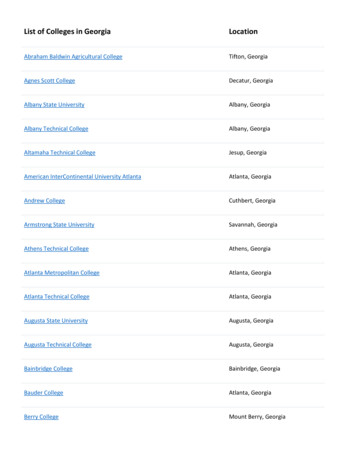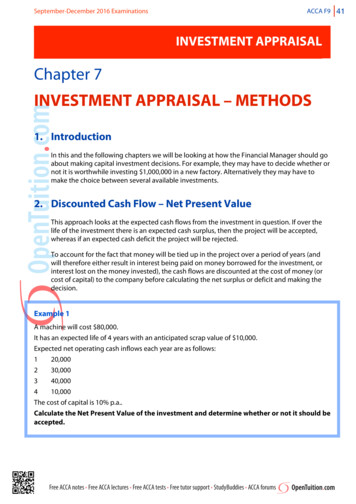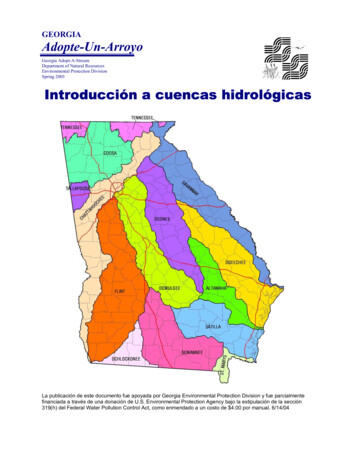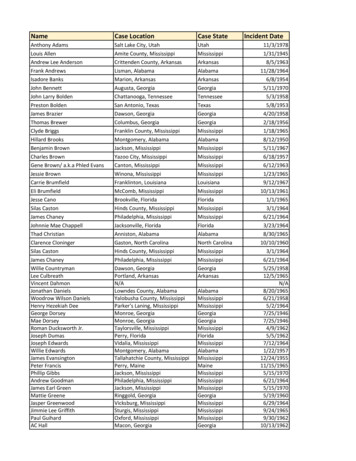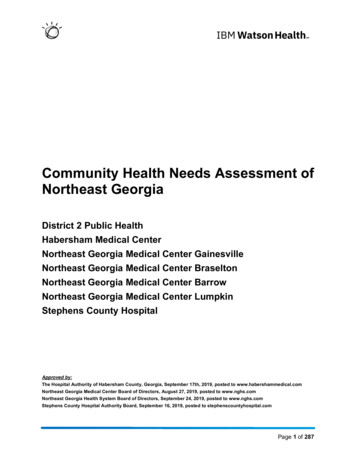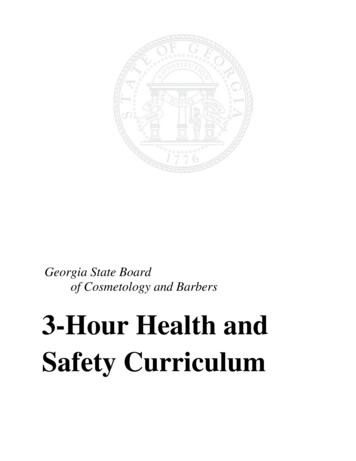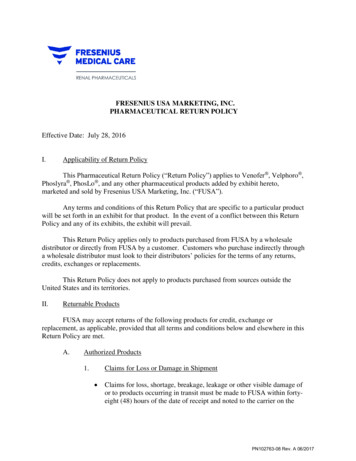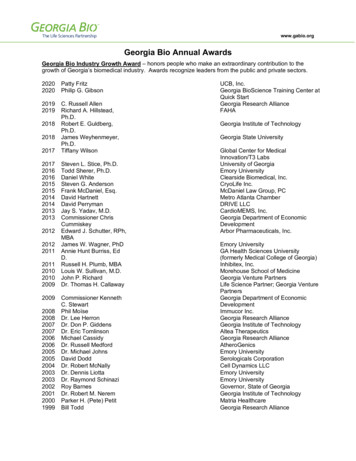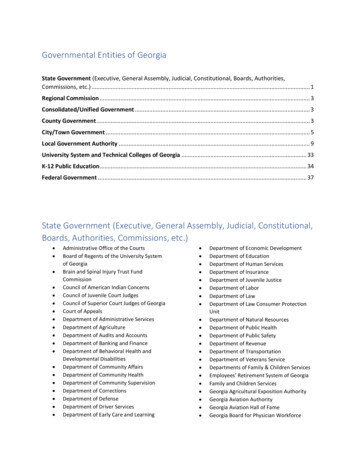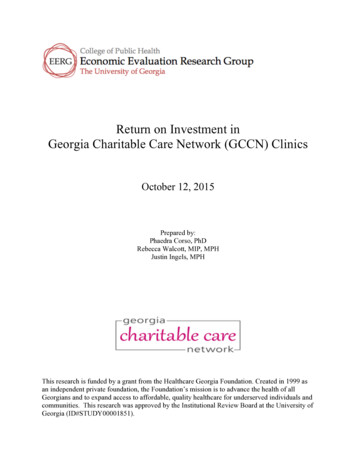
Transcription
Return on Investment inGeorgia Charitable Care Network (GCCN) ClinicsOctober 12, 2015Prepared by:Phaedra Corso, PhDRebecca Walcott, MIP, MPHJustin Ingels, MPHThis research is funded by a grant from the Healthcare Georgia Foundation. Created in 1999 asan independent private foundation, the Foundation’s mission is to advance the health of allGeorgians and to expand access to affordable, quality healthcare for underserved individuals andcommunities. This research was approved by the Institutional Review Board at the University ofGeorgia (ID#STUDY00001851).
Table of ContentsExecutive Summary . .3Purpose of this Study .4Description of GCCN Data .5Objective I .8------Cost to Treat Hypertension in GCCN Clinics Compared to OtherHealthcare Provider/Payer SettingsObjective II 12------Cost-savings from Avoided Emergency Department (ED) Visitsfor all Chronic Disease PatientsObjective III .15------Cost-savings from Hypertension Treatment/Management in GCCN ClinicsConclusions . .21References .222
Executive SummaryThe Georgia Charitable Care Network (GCCN) is a non-profit organizationwhose primary mission is to foster collaborative partnerships to delivercompassionate health care to low income Georgians. The network contains over 90charitable and free clinics and hundreds of physicians and dentists that serve theuninsured in Georgia. GCCN helps to strengthen the state’s healthcare safety netby empowering organizations that serve vulnerable populations.The purpose of this study was to conduct several analyses to determine thecost-savings associated with the treatment of patients in GCCN clinics. We werespecifically interested in the cost-savings associated with the treatment andmanagement of hypertension patients. As preliminary steps, however, weestimated the cost to treat hypertensive patients in a GCCN clinic versus otherhealthcare payer/provider settings and the cost-savings associated with avoidedemergency department visits.We estimated that treating hypertensive patients in GCCN clinics is lessexpensive than treating them in other healthcare provider/payer settings, includingfederally qualified health centers (FQHCs), Medicaid, private insurance, anduninsured/out-of-pocket payers. FQHCs were almost 2 times more expensive thanGCCN as the payer; Medicaid was 2.5 times more expensive; and uninsured/outof-pocket patients as the payers were more than 4 times more expensive comparedto GCCN clinics. We also estimated that treating chronic disease patients in GCCNclinics is a cost-saving alternative when considering the number of emergencydepartment visits avoided; for every 100 patients that visit a GCCN clinic annually,ED visits avoided saves more than 50,000. Subtracting the cost to care for those100 patients in GCCN clinics produces a net benefit, or savings of 26,000. Thatis, for every 1 spent on a cohort of 100 chronic disease patients in a GCCN clinic,there is a benefit of 2.Finally, we calculated the cost-savings resulting from treating and managinghypertensive patients in a GCCN clinic. For every 100 patients treated annually,we estimated that 13,500 and 5,700 are saved in reduced coronary heart disease(CHD) events and stroke, respectively, and 46,600 are saved in reduced ED visits.When adjusted for the annual expenditures to treat 100 patients annually in GCCNclinics ( 41,250), we estimated that for every 1 spent by GCCN clinics, there is asavings of 1.60, on average. This represents a savings of 24,500 for every 100patients treated/managed for hypertension in GCCN clinics.Based on the results of these analyses, there is strong economic evidence tosupport investment in GCCN clinics across the state for the treatment andmanagement of hypertensive patients. It is likely that the treatment of other chronicconditions in GCCN patients would also provide positive economic returns.3
Purpose of the StudyMonitoring and controlling chronic illnesses decreases the likelihood of expensiveemergency department visits and inpatient hospital admissions, and access toprimary care is a necessary component of proper disease management. Thepurpose of this study is to show how clinics in the Georgia Charitable CareNetwork (GCCN) are an effective, cost-saving way to provide primary care to theuninsured populations in the state. GCCN has already demonstrated savings to thestate in terms of direct medical costs, but we have expanded this perspective to alsoshow savings accrued through the clinics’ contribution to improved healthoutcomes. Our specific objectives included estimating the following summarymeasures:Objective I: Cost to Treat Hypertension in GCCN Clinics Compared toOther Healthcare Provider/Payer SettingsObjective II: Cost-savings from Avoided Emergency Department (ED)Visits for All Chronic Disease PatientsObjective III: Cost-savings from Hypertension Treatment/Management inGCCN ClinicsTo determine the cost-savings of treatment and management for hypertension inGCCN clinics (Objective III), we compared the cost of managing a patient withhypertension in a GCCN clinic for one year to the savings resulting from reductionin blood pressure. When blood pressure is reduced, savings occur from reducedrates of coronary heart disease (CHD) events and stroke. We also included in thisanalysis the savings resulting from the reduced utilization of emergencydepartments (ED). To these savings we subtract the expenditures required to treathypertensive patients. Estimates needed to conduct these analyses included: thecost of treating hypertension in a GCCN clinic compared to other healthcareprovider/payer settings (Objective I) and the cost-savings associated with avoidedED visits for any chronic-disease patient visiting GCCN clinics (Objective II).The summary measures we calculated to estimate cost-savings are common in thefield of economic evaluation, including a net-benefits measure, a benefit-cost ratio,4
and a return on investment (ROI) calculation. Net benefits (NB) are derived bysubtracting a program’s expenditures from an estimate of a program’s savings orbenefits, in monetary terms. NBs greater than 0 suggest that there is an economicrationale for funding a program. A benefit-cost ratio (BC ratio) is derived bydividing a program’s benefits or savings by a program’s expenditures. BC ratiosgreater than 1 suggest that there is an economic rationale for funding a program.Finally, the ROI is calculated by dividing a program’s estimate of net benefits(NB) by a program’s expenditures. Like the NB measure, an ROI greater than 0reflects an economic incentive for funding a program.Description of GCCN DataTo conduct this study, we contacted 95 participating GCCN clinics and requestedaccess to the following data for the 2013 calendar year:1. General operating information:a. Total annual operating expenditures;a. Number of unique patients served annually;b. Number of patient visits annually; andc. Level of prescription assistance provided at each clinic (freepharmacy, subsidized pharmacy, no medication assistance, etc.)b. Data specifically related to the management of hypertension:a. Number of hypertension screenings performed; andb. Clinic data for newly diagnosed hypertension patients in 2013 and 1year of patient data post-diagnosis, including age, gender, race, bloodpressure at initial screening, and blood pressure at 1-year follow-upFrom the 95 clinics, excluding 8 clinics from consideration because they were notin operation for all of 2013, we received data on a) number of patients servedand/or b) number of patient visits from n 53 clinics, or 61% of the network. Weobtained annual operating costs or costs per visit for n 18 clinics (or 21%); and wereceived data specific to hypertension management from n 12 clinics (or 14%).Table 1 lists all of the GCCN clinics in 2013, highlighting those clinics providingdata used in these analyses.5
NameCompassionateCareClinicu leSOSCommunityClinicu BibbGwinnettMaconVolunteerClinic u TheHeartsandHandsClinic u eerClinicCarrollGwinnettRaphaClinicofWestGeorgia u n LaClinicaBuenSamaritanoGwinnettCommunityClinic u ChathamHabershamGraceGateClinicu ClinicaCentroHispanicGoodNewsClinics u ChathamHallCommunityHealthMissionu HandsofHopeClinicu tyClinic u n JonesRockSpringsClinic u ClarkeLamarAthensNursesClinic u MercyHealthCenter u artnershipHealthCenter u aceFreeMedClinicu ClaytonLumpkinBreadofLifeHealthClinicu ClaytonMaconGoodShepherdClinic u n CommunityHealthClinicu lthCenteru mtyOutreachClinicu MedicalMissionClinicCobbMcDuffieFaithCareClinicu MercyMedofColumbusu iaSAIClinicu MuscogeeCowetaSamaritanClinicu icu WillingHelpersMedicalClinicu houseFoundationu GoodSamaritanHealth&WellnessCenteru DekalbPickensPhysiciansCareClinic u RichmondCountyMedSocietyProjAccessu MakingMinistriesDoughertySamaritanClinicu RichmondTheCarePlace u stMedical/DentalClinicu CareClinic u c u icofRome u llusHealthClinicu ForsythScrevenCenterforBlackWomen’sWellnessu HopeHealthClinicu FultonSpaldingTheGoodSamaritanHealthCenter u OpenArmsClinicu FultonStephensAlFarrogMasjidFreeClinicu FultonToombsMercyMedicalClinic&Found. u n n CommunityAdvancedPracticeNursesu TroupCaresMedicalClinicu FultonTroupGrantParkFamilyHealthCenteru rFultonWaltonBenMassellDentalClinicu FISHMedicalClinicu ommunityHelpingHandsHealthClinicu hMedicalMinistryu GlynnWhitfieldHealingHandsClinicDEOClinicu WhitfieldGoodSamaritanHealthCenteru GwinnettRedShaded NotOperationalinAllof2013;GreenShaded ProvidedPatient- ‐levelDataonHypertensionProvidedDataonCosts ;on#ofPatientsand/or#ofPatientVisitsu ;onAgen ;onSex ;andonRace/Ethnicity .6
Table 2 provides a description of the data received by the clinics, excluding theinformation on hypertension that is covered in the next sections. A few clinicsprovided data on the demographics of their patient population; however, these datawere not generalizable to the entire GCCN population, and therefore we could notrely on them to adjust our estimates of risks and costs.Table 2: Descriptive Statistics of Data Received from Clinics#of Clinics# ofPatients in2013(range)48Mean: 2114Median: 782(128-12502)5018# of PatientVisits in n)Mean: 88Median: 70(9.37313.90)%Female% Race ofPatientsMean: 6847Median: 4123(306-32122)4Mean: 52.5Median: 53(21-83)64Age ofPatients inyears(range)6.568.939.9 Black50.7 White6.5 Hispanic7
Objective I: Cost to Treat Hypertension in GCCN ClinicsCompared to Other Healthcare Provider/Payer SettingsWe compared the annual costs of treating hypertension (HTN) in a GCCN clinic to the annualcosts in four alternative provider/payer treatment settings: (1) Federally Qualified Health Centers(FQHC), (2) Medicaid provider/payer, (3) private insurance in an outpatient setting, and (4) anuninsured/out-of-pocket payer in an outpatient setting.N 12 clinics provided us with detailed patient-level dataon hypertension management, shown in Figure 1. Theyrepresent twelve of the eighteen public health districtsacross the state of Georgia. The clinics include: BethesdaCommunity Clinic in Cherokee County, the Free Clinicof Rome in Floyd County; Good News Clinics in HallCounty; Good Shepherd Clinic in Clayton County;Macon Volunteer Clinic in Bibb County; PartnershipHealth Center in Lowndes County; Physicians’ CareClinic in DeKalb County; Rock Springs Clinic in LamarCounty; The Care Place in Douglas County; MercyMedical Clinic in Toombs County; Gwinnett CommunityClinic in Gwinnett County; and the Athens Nurses Clinicin Clarke County.Methods and onHTNpatientsGCCN Expenditures: From data collected at the 12clinics, we estimated that each hypertension patient visited the clinic on average 5.5 times in theyear. In a sensitivity analysis, we varied this from 5 visits (Athens Nurses Clinic, personalcommunication, August 26, 2015) to 6 visits (Song et al., 2013). For the average cost of a GCCNclinic visit, we used data shown in Table 2 for n 18 clinics providing cost data. We chose to notuse the mean cost per visit in an effort to decrease the influence of outliers. The adjusted meanafter elimination of outliers was 75/visit. Multiplying 75/visit by 5.5 visits/year results in anannual cost of 413 for treating HTN in a GCCN clinic. Because GCCN patients participate inPrescription Assistance Programs (PAPs), medication costs to the clinics and/or patients are 0.FQHC Expenditures: According to the National Association for Community Health Centers, theaverage cost for a medical patient visit in a Georgia FQHC is 140 ( 137 in 2012 US ). It isunclear whether or not this estimate includes medication costs. Assuming the same number ofvisits per year as our GCCN sample (5.5 visit per year), the annual cost to treat a hypertensivepatient in an FQHC is 770.Medicaid Expenditures: Trogden et al. (2007) use MEPS data to model the annual attributablecosts of chronic diseases in different payer settings. After adjusting to 2013 , the annualattributable Medicaid costs of hypertension are 2071 ( 1608 in 2005 US ); however, thesecosts include hospitalization and medical device expenditures in addition to office visit and8
medication costs, and they are therefore inappropriate comparators for GCCN hypertensiontreatment expenditures. A study by Garis and Farmer (2002) breaks down the cost categories forhypertension Medicaid expenditures, and we incorporate their finding that 52.9% of the totalattributable annual cost is due to office visits and medications. Applying this percentage to thetotal expenditures found by Trogden et al. (2007), we estimate the annual cost to treathypertension in a Medicaid setting to be 1096.Private Insurer Expenditures: We again used Trogden et al. (2007) and Garis and Farmer (2002)to estimate hypertension treatment costs to a private insurer. The model by Trogden et al. (2007)reveals an annual cost of 1088 (2005: 845) for hypertension management. Applying the samepercentage (52.9%) to the total expenditures found by Trogden et al. (2007), we estimate theannual cost to treat hypertension in a private insurance setting to be 576.Uninsured Expenditures: We estimated the average cost of an office-based visit to be 231(AHRQ 2008: 199 in 2008 US ). Assuming the same number of visits per year as our GCCNsample (5.5), the annual cost of office visits to an uninsured hypertensive patient is 1270.50. Ina sensitivity analysis, we use the cost of an urgent care visit ( 100, Georgia Health News, 2013)instead of the average cost of an office visit to obtain a more conservative estimate for uninsuredhypertension management costs. We use the Express Scripts 2013 Drug Trend Report’s monthlycost for hypertension medication, 40.04, as a conservative estimate of medication costs for anuninsured individual. Adding the annual office visit costs ( 1270.50) to the annual medicationcosts ( 480.50) produces an annual hypertension treatment cost of 1751.Results:Even in a worst-case scenario, hypertension management in a GCCN clinic is less costly than inother settings (Table 3). Our baseline estimate for annual hypertension treatment in a GCCNclinic is 412.50 ( 340- 528), and theclosest alternative in terms of cost is 2,000.00treatment under a private insurer ( 576),GCCNwhich is not a realistic option for much 1,500.00of the GCCN population. The annualFQHCcost to FQHC’s for a similar cohort of 1,000.00Medicaidhypertensive patients is approximately 770, and annual Medicaid expendituresPrivate 500.00are 1096. The most expensive treatmentUninsuredsetting is one in which the hypertensive 0.00patient is uninsured ( 1751), and thisCostsetting is often the only vepatienta taavailable to the GCCN lation if treatment within a GCCNclinic is not possible.9
Table 3: Comparison of Annual Costs to Treat HTNBaselineBest caseWorst caseNumber of visits5.556Cost per visit 75 68 88Medication cost 0Annual clinic costs per patient 412.50 340 528Number of visitsCost per visitAnnual cost per FQHC patient5.5 140 77065 840 700Annual costs per Medicaid patient 1096Annual costs per private insurance patient 57665 100 1866.50 980.50GCCN ClinicFQHCUninsuredNumber of visitsCost per visitMedication costAnnual costs per uninsured patient5.5 231 480.50 1751Limitations of the Analysis:The healthcare system perspective of this analysis is limited in that it only includes costs to thehealthcare provider, which may or may not include the costs of medications. Although these arenot costs that are realized by the GCCN clinics, medication does represent a cost to some part ofthe healthcare system (even if they are overstock and provided for “free” or reduced prices).From a societal perspective, the cost of medications would have to be included, even if they are“free” to hypertension patients within the network. Costs to patients would also be added,including productivity losses and any healthcare costs paid out of pocket.Further, hypertension management costs can vary greatly depending on the severity of thedisease in the individual patient. We tried to model a consistent cohort of patients for the GCCNand uninsured treatment settings (5.5 visits/year), but the hypertensive populations for theFQHC, Medicaid, and privately insured treatment settings may differ in severity.10
For the annual costs to treat hypertension in an FQHC, we incorporated the average cost of anFQHC medical visit. It is unknown how a hypertension medical visit compares in cost to othertypes of medical visits at an FQHC. We are also assuming that this cost estimate includesmedication. If medication costs are not included, then our FQHC estimate is biased against ourresult and is therefore a conservative estimate.To determine Medicaid and private insurer expenditures, we followed Garis and Farmer (2002)in assuming that 52.9% of annual hypertension expenditures can be attributed to office visits andmedication costs. It is possible that this percentage varies considerably among patients.Conclusions:Despite the limitations of this analysis, in a comparison with other treatment settings, ourcalculations suggest that GCCN clinics provide a cost-efficient alternative for chronic diseasemanagement.11
Objective II: Cost-savings from Avoided EmergencyDepartment (ED) VisitsWe used data from N 45 clinics providing number of unique patients served to calculate savingsfrom reduced emergency department (ED) visits. For this analysis, we excluded data from threeclinics specializing in dental, chiropractic, and vision/hearing (Ben Massell Dental Clinic inFulton County, Life University Community Outreach Clinic in Cobb County, and Georgia LionsLighthouse Foundation in DeKalb County), as patients in these clinics should not be expected tohave the same ED avoidance rate as patients to general medical clinics.Methods and Assumptions:The perspective of this analysis is that of the healthcare system; that is, expenditures and avoidedcosts are those accrued by the healthcare system only (regardless who actually pays the costs).The study time period includes clinic visits and costs for 1 year. All costs are presented in 2013US , using the medical component of the consumer price index (CPI) to inflate all olderhealthcare costs. Discounting is not necessary because of the 1-year study time frame.The total number of unique patients served by the 45 clinics in 2013 is 91,262, representingapproximately 3.5 visits per patient. In this analysis, we present the results for a cohort of n 100patients visiting a clinic in the network.Incidence of Reduced Emergency Department (ED) Visits: Following Oriol et al. (2009), Bicki etal. (2013), and Song et al. (2013), we estimated the proportion of clinic patients who would havechosen to visit an ED if the free clinic was not available to provide care and then calculated thesavings accrued from these avoided ED visits. Our baseline estimate for percentage of clinicvisits that would have resulted in an ED visit had the clinic been unavailable is 49%, which is thevalue derived by Bicki et al. (2013) through patient self-report. As in Song et al. (2013) andNadkarni and Philbrick (2003), we apply this proportion to the patients’ first visit to the clinic in2013 and not to every visit in order to provide the most conservative estimate. Thus, 100 patientstreated in a GCCN clinic resulted in 49 avoided ED visits in 2013. In a sensitivity analysis, weassume an upper bound of 78% ED visits averted (Athens Nurses Clinic, personalcommunication, August 26, 2015) and a lower bound of 34.5% ED averted (Nadkarni &Philbrick, 2003).Unit Cost of ED Visits: We estimated the average expense of an ED visit to be 1068 (AHRQ2008: 922 in 2008 US ). For a more conservative estimate, we used 413, the reported cost ofan ED visit for a sore throat and flu symptoms at Athens Regional Medical Center, where a 40%discount was applied for being uninsured (Georgia Health News, 2013).Unit Cost of GCCN Visit: For the average cost of a GCCN clinic visit, we did not use the meancost per visit, 88.21, calculated from the sample (Table 2), because the data contained outliers.Instead, we eliminated all cost per visit values that were /- 3 standard deviation points awayfrom the mean, thus eliminating n 1 cost/clinic value ( 314/visit). The adjusted mean after thiselimination was 75/visit. In a sensitivity analysis, we use 88 (the unadjusted mean cost per12
visit from our data) and 68 (when we eliminated cost per visit values greater than 1 standarddeviation from the mean).Results:We estimate that for every 100 patients that visited GCCN clinics in 2013, a total of 49emergency department (ED) visits were avoided, saving more than 50,000 (Table 4).Subtracting the GCCN cost to care for those 100 patients produces a net benefit of 26,000. Thatis, for every 1 spent on a cohort of 100 GCCN patients, there is a benefit of 2; thus making thereturn on investment nearly 100%. In the best case scenario, where the percent of ED visitsavoided is greater and the annual costs per GCCN patient are lower, returns on investment areeven more impressive – for every 1 spent there is 3.50 in savings (Table 4).In the worst-case scenario, when the percent of ED visits avoided is lower and the costs per EDvisit are also considerably lower, benefits do not outweigh costs. However, when the percent ofED visits avoided is varied (from 34.5% to 78%) without varying any other parameter, netbenefits remain positive and range from approximately 10,000- 57,000.Table 4: Savings from Emergency Department Visits Avoided per 100 PatientsBaselineBest caseWorst case497834.5Emergency Department SavingsNumber of ED visits avoided per100 patientsCost per Avoidable ED VisitTOTAL ED SAVINGSGCCN ExpendituresNumber of visits per year (for thesample)Cost per GCCN clinic visitTOTAL GCCN EXPENDITURESper 100 patients per yearNET BENEFITS(Savings - Expenditures)BENEFIT-COST RATIO(Savings/Expenditures)RETURNS ON INVESTMENT([Savings – Expenditures] / Expenditures ) 1,068 52,332 83,304 14,249 75 26,250 68 23,800 88 30,800 26,082 59,504- 16,5512.03.50.460.992.5-0.543.5 41313
Limitations of the Analysis:There are several limitations of this analysis. Our estimates for the proportion of clinic visitsresulting in avoided ED visits is based on the results from surveys conducted at clinics withlimited samples of patients. These estimates could be biased by self-reporting bias, type ofdiagnosis, access to healthcare providers, Medicaid eligibility, etc. Further, ED costs are quitevariable depending on the source, the geographic location, and the diagnosis. There have beensome estimates in the literature that have shown the average charge for an ED visit to be morethan 2000 per visit (in 2008 ; Caldwell et al., 2013). To be conservative in our estimates,however, we do not estimate a best-case, only a worst-case, scenario on costs of an ED visitbecause the savings are already quite high.Conclusions:The services provided by GCCN clinics offer Georgia’s uninsured population a cost-savingalternative to the emergency department (ED) in the base-case and best-case scenarios. Becausethe ROI results are greater than 0 for the base-case and best-case scenarios, we can conclude thatthe program is producing savings that exceed its costs for the general chronic-disease population.Although the worst-case scenario does not reflect an economic return on investment, theeconomic returns remain positive when percentage of ED visits avoided is varied and all otherparameters are held constant in the model.14
Objective III: Cost-savings from HypertensionTreatment/Management in GCCN clinicsTable 5 below provides descriptive statistics for the hypertensive patients visiting the N 12clinics shown in Figure 1 (see Objective I).Table 5: Descriptive Statistics for the Hypertension Patients from N 12 Clinics.Initial Blood PressureNumber ofHypertensionPatientsMean: 138.42Range: 49-283Total: 1661 patientsNumber ofHypertensionVisits/Year (fromn 4 clinics only)Mean: 5.5Median: 5Range: 2-25SystolicDiastolic147.9090.80Follow-up Blood Pressureat 12 Mos.SystolicDiastolic137.7184.49Methods and Assumptions:Following Song et al. (2013), we looked at a) how blood pressure reduction resulting fromhypertension management can lead to cases of coronary heart disease (CHD) events and strokeaverted and their associated costs; and b) how clinic visits reduce emergency department (ED)utilization and costs. The perspective of this analysis is that of the healthcare system; that is,expenditures and avoided costs are those accrued by the healthcare system only (regardless whoactually pays the costs). The study time period includes incidence and costs for 1 year. All costsare presented in 2013 US , using the medical component of the consumer price index (CPI) toinflate all older healthcare costs. Discounting is not necessary because of the 1-year study timeframe.We use data from 1661 hypertension patients visiting n 12 GCCN clinics, assuming an agerange of 50-59 years old. This age range is consistent with the population range used by Law etal. (2009) to estimate CHD and stroke risk reductions and also contains both the mean age (52.5)and median age (53) for patients in our sample (Table 2).Incidence of CHD and Stroke in Georgia: The incidence rate of CHD events in Georgia in 2013was not readily available. Further, definitions of a CHD event vary in the literature. For example,Song et al. (2013) used baseline incidence for CHD as defined by the MassachusettsFramingham study: angina pectoris, myocardial infarction (MI), coronary insufficiency anddeath caused by CHD. The National Heart, Lung, and Blood Institute (NHLBI) includes acuteMI and angina pectoris when defining CHD. Law et al. (2009) define a CHD event as fatal ornonfatal MI or sudden cardiac death. We define a CHD event given the following diagnosiscategories available in Georgia’s Online Analytical Statistical Information System (OASIS)database: high blood pressure, hypertensive heart disease, obstructive heart disease includingheart attack, and aortic aneurism. As a proxy for incidence we summed the 2013 annual hospital15
discharge rate and death rates for these diagnoses, equal to 7.9/1000 for ages 50-59, all genders,all races. The other source used in a sensitivity analysis is from Song et al. (2013): 11.4/1000.We define the baseline incidence of stroke as ischemic or hemorrhagic, following Song et al.(2013), because the Georgia OASIS database does not differentiate by type of stroke. For abaseline annual incidence of stroke, we used 3.2/1000, which is equal to the 2013 rate of hospitaldischarges and deaths for stroke, for ages 50-59, all genders, all races. This estimate is similar toother estimates used in the literature, including Song et al. (2013), which was 3.3/1000.Unit Costs of CHD and Stroke: For unit costs we used the Coronary Heart Disease Policy Model,which is a validated model that has been used to assess effects and costs of different CHDprevention and treatment strategies for over two decades (Moran et al., 2015; Weinstein et al.,1987). From the Policy Model we used costs of acute MI fatal and non-fat
We compared the annual costs of treating hypertension (HTN) in a GCCN clinic to the annual costs in four alternative provider/payer treatment settings: (1) Federally Qualified Health Centers (FQHC), (2) Medicaid provider/payer, (3) private insurance in an outpatient setting, and (4) an
